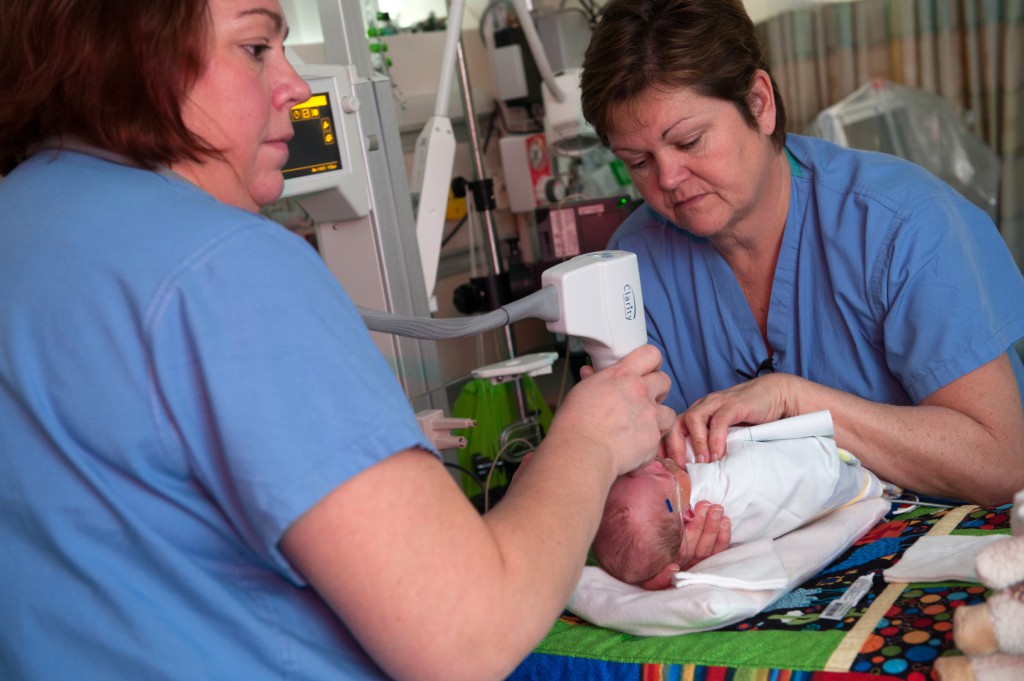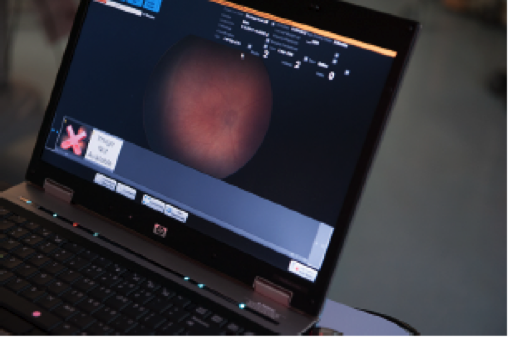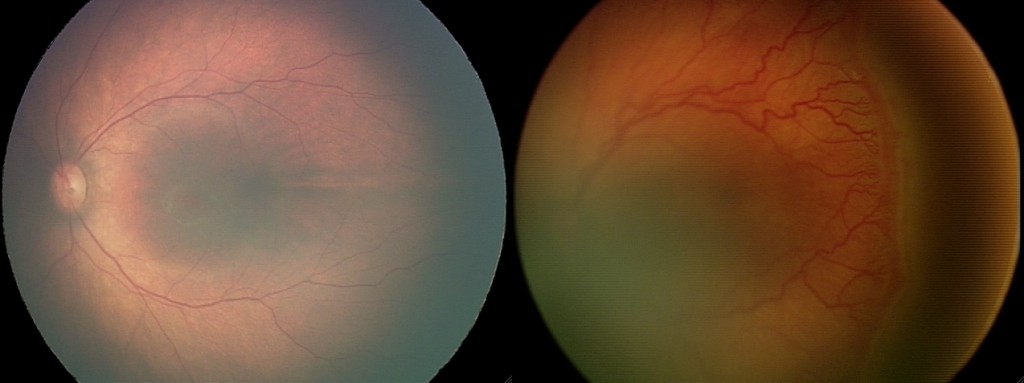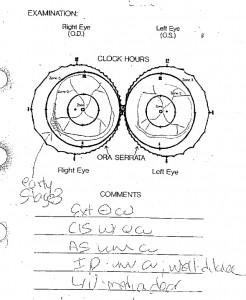
Gretchen Hamn (L) and Margie Young screen a premature infant for retinopathy of prematurity. (Photos: Katherine C. Cohen)
We’re in the Neonatal Intensive Care Unit at South Shore Hospital. Six tiny, swaddled preemies are ready to be examined, their eyes numbed and their pupils dilated with special drops.
Gretchen Hamn, NNP, and medical assistant Margie Young go from isolette to isolette. Young tends to the first baby and gently positions him for his exam. Hamn pulls over a cart and extends a kind of hose with a camera at the tip. This she places directly on each of the baby’s eyes, taking a digital video of his retinas. His heart rate alarm goes off, a sign that he’s not happy with this exam, and he lets out a weak cry. Within a minute or so, the exam is over, and Young tucks him back in.
Hamn is screening the six babies for retinopathy of prematurity (ROP), a major cause of blindness (blind Motown artist Stevie Wonder had it). ROP screening is required for babies born at or before 30 weeks gestation or weighing 1500 grams or less. The more premature the baby, the greater the risk: About 10 percent of babies born at 32 weeks’ gestation, and as many as 95 percent of babies born at 23 weeks, develop ROP. If ROP is caught early enough, it can be treated with laser therapy or medication.
 Hamn now reviews the video, freezing it from time to time and saving still images—six different views—that will help ophthalmologists at Boston Children’s Hospital determine whether the baby is developing ROP. Later she’ll transmit these images to Boston Children’s through a secure system.
Hamn now reviews the video, freezing it from time to time and saving still images—six different views—that will help ophthalmologists at Boston Children’s Hospital determine whether the baby is developing ROP. Later she’ll transmit these images to Boston Children’s through a secure system.
The first two babies are free and clear, but Hamn readily spots a telltale light line that indicates ROP on the third baby’s retina. It’s a sign of abnormal growth of the blood vessels that feed the retina. The leaky, tangled vessels form a rigid band of tissue. If this worsens and is left untreated, it could cause the retina to detach and the baby to go blind.
Doctors used to come to South Shore Hospital’s NICU to do this exam manually, looking directly into the retina through the pupil and drawing by hand pictures of what they saw. “They would have to use a speculum to open the eye and a probe to move the eye around and look through a magnifying glass,” says Hamn. “The baby would be crying the whole time. Now, I can take a picture directly, and I like that everyone is seeing the same thing.”
Later, in her office at Boston Children’s, ophthalmologist Carolyn Wu, MD, calls up the images on her computer screen (in urgent cases, they can be viewed on iPhones) and identifies which babies have ROP, and at which stage. She can track their progress on repeat camera screenings, done at least weekly while the babies are in the NICU. “Most ROP goes away,” says Wu. “Less than 10 percent of babies who are screened develop ROP that requires treatment.”

At left, a peripheral view of a healthy retina. At right, a retina with ROP (note the semicircular light band along the right side, beyond which no blood vessels grow).
Any baby with ROP findings warranting referral is transferred from South Shore Hospital to Boston Children’s NICU for further evaluation and treatment. After hospital discharge, all babies who qualified for ROP screening (whether or not ROP was found) see Wu or one of her colleagues in person for a manual exam, either in Boston or in the outpatient clinic in Weymouth.
The telemedicine system, which Boston Children’s hopes to take to other hospitals in its network, solves a major problem for South Shore Hospital. Multimillion dollar lawsuits around the country, involving babies that went blind, have led many community ophthalmologists to drop ROP screening from their practices. If ROP is missed, or caught but not treated soon enough, physicians are held liable—even when patients don’t come to their appointments.
“We had an ophthalmologist, but his practice opted to no longer perform this service because of the malpractice insurance costs,” says Hamn. “If we couldn’t establish a way for the infants to be screened, we would have had to start transferring them to Boston Children’s for screening.”
Boston Children’s Hospital, with its large Ophthalmology team, is often asked by NICUs around Massachusetts to perform ROP screenings. But even for nearby South Shore Hospital, the screenings would take the Boston physicians half a day, between travel time and waiting while the babies were cared for and for the drops to take effect.
“Previously, we had to say ‘no’ to a lot of NICUs. We just didn’t have the capacity,” says David Hunter, MD, PhD, ophthalmologist-in-chief at Boston Children’s. “Now, the nurses can do the screening when it makes sense to them, without the intrusion of us coming in, and without our ROP specialists having to travel around the state. Patients can stay at the community hospital, and families can be closer to their new baby.”
Tele-ROP, as the project is called, began with work Wu did as a fellow nearly a decade ago with Boston Children’s ophthalmologist Deborah VanderVeen, MD. She tested the digital retinal camera in the NICU in 43 infants and found it compared well with her manual exams, missing no instances of treatable disease.
The collaboration represents a new business model for both hospitals. Health insurers reimburse South Shore’s NICU for the screenings, and the NICU, in turn, pays Boston Children’s ophthalmology department under a separate annual contract.
“Initially it seemed like a foreign concept for one hospital to pay another for this service,” says Gordon Massey, MBA, Ophthalmology administrator. “But given the high liability risk and the better access to screening, outlying hospitals are starting to understand the wisdom of the practice.”
The Tele-ROP program is part of a larger telehealth and telemedicine initiative led by Boston Children’s Hospital’s Innovation Acceleration Program. A similar initiative called TeleConnect allows critical care staff at Boston Children’s to evaluate emergency room patients at South Shore when a transfer is contemplated.
“This type of virtual clinical evaluation is a care delivery model of the future,” says Chief Innovation Officer Naomi Fried. “We look forward to creating similar partnerships with community hospitals for a variety of medical conditions.”








